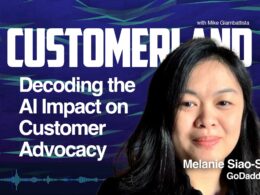We spend a lot of time thinking about how to engage prospects and customers. How do we build the customer base? How do we get the most out of our budgets? My approach to this begins with anchoring in the key metric to measure engagement: Customer Lifetime Value, (CLV). In practicing Relationshipping – the art and science of bonding the consumer to the brand digitally – an important starting point is to unify media efforts and measuring results using CLV.
by George Wiedemann
That means Relationshipping begins in digital media, via platforms that, minute by minute, individual by individual, are recording consumer demand for your brand and its competitors.
It is essential to pay attention to where the puck is going, not where it was. You saw that in 2018 digital media advertising spend in the US exceeded the expenditure in television. We now have a majority of that spend going to Amazon, Google, and Meta. TV is still powerful in its capacity to generate awareness – even if it is shifting shape, thanks to streaming and addressable options. Brands will continue to need TV/streaming and use it for awareness. The traditional media will continue to be part of the mix. But it is important to adjust to the customer being in control, beginning with digital media, and thereby transforming traditional media into a role of supporting Relationshipping.
Relationshipping starts with an individual’s online behavior and continues by engaging that prospect through media focused on measurable conversion. Prospects’ identities reside in digital spaces, so brands can not only target relevant audiences, but also take the first steps towards a relationship with personalized (and near personalized) conversations. Those interactions often allow the prospect to raise their hands, click and opt into the brand relationship voluntarily.
It is ironic that the tremendous advance of digital media gives brands greater efficiency and effectiveness while simultaneously fracturing customer experience. After all, much offline creative takes place in a siloed context. In addition to digital media, we still have all the other effective offline efforts – TV, radio, print, direct mail, and sales promotion materials. A cohesive, unified brand strategy involves pulling together all campaign touchpoints and communications elements into consistent brand Relationshipping communications enabling an enhanced customer experience.
Most media firms have a director of integrated media – a discipline that focuses fundamentally on the results of all media placements. Analytics is now tying those together with a final measurement: Customer Lifetime Value (CLV). Allow me to repeat that evaluation which exclusively focuses on middle metrics like cost-per-click or per-visit may not be reflective of an enhanced customer experience and they can cost your brand millions in engagement budget waste.
Given that a big contributing factor to the fractured customer experience has been the siloing of the media functions, it’s essential to restore a holistic approach to media touchpoints. The effort toward unification relies on applying a Relationshipping strategy to all media efforts. From experience in both client and agency organizations let me caution that this is hard and requires consistent management review. Unification isn’t easy.
Relationshipping strategy involves a return to a discipline that existed before the trend toward disparate, siloed communication disciplines – with media in one company, direct in another, sales promotion in another, and so on. How can you begin to tie it all back together? You can start by uniting all the contributing disciplines with a single brand Relationshipping Strategy using this disciplined approval document:
Brand Relationshipping Strategy
- What message?
- Do we want what prospects or customers to receive?
- In the face of what competition?
- Supported by What Analytics? (i.e., Where are they online? What keywords do they use? Is our site set to harvest the data?)
- Delivered by what media or platforms, across what calendar?
- Supported by what linked technology platforms?
- Using what brand image, positioning, engagement invitations, offers and calls to action?
We are just seeing the beginning of silo walls coming down with the effort to unify all communication efforts with a consistent, effective, journey-long customer brand experience. After 40+ years of specialization and siloing, our challenge in the C-suite is to knit marketing back together. These seven essential questions generate a Relationshipping Strategy process document that should be reviewed and approved by at least six agency or internal marketing officers, as well as the key brand stakeholders (CMO of course, and Product Management). The agency executives, or internal marketing executives should include:
- Chief Strategy Officer
- Chief Creative Officer
- Account Director
- Media Director
- Chief Technology Officer
- Chief Analytics Officer
By answering the seven key questions and getting the sign offs, you unify all the messages in media, developing a consistent customer experience with the brand. An approved, interdisciplinary strategy document helps to generate creative and content that are unified across the journey. All touchpoint communications should focus on optimizing CLV, which demands that engagement messages work together in serving the customer consistently.
Please share your thoughts and experiences with getting your company’s media touchpoint messages working together and measured.
 George Wiedemann was founder and CEO of Grey Direct for 21 consecutive years of worldwide growth; CEO of pioneer Silicon Valley email platform Responsys; and CEO of The DRUM Agency. He is founder and CEO of Relationshipping Consulting, focusing on bringing efficiencies to large-scale enterprises through deep budgetary analysis and process alignment. George is also a frequent contributor to TheCustomer.
George Wiedemann was founder and CEO of Grey Direct for 21 consecutive years of worldwide growth; CEO of pioneer Silicon Valley email platform Responsys; and CEO of The DRUM Agency. He is founder and CEO of Relationshipping Consulting, focusing on bringing efficiencies to large-scale enterprises through deep budgetary analysis and process alignment. George is also a frequent contributor to TheCustomer.
Photo by Jonny Gios on Unsplash.











